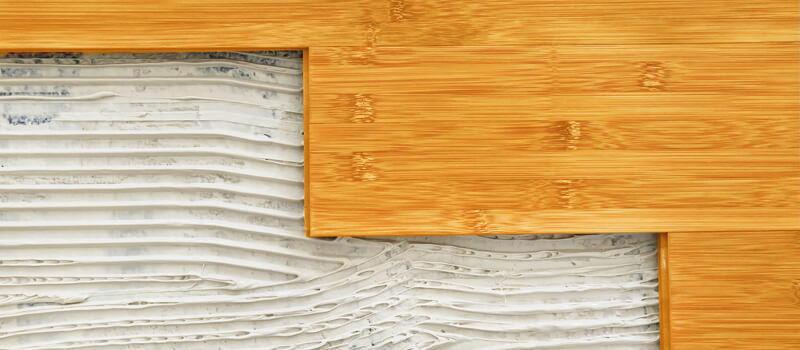Imagine stepping into your home and feeling the cool, smooth touch of bamboo beneath your feet. It’s a luxurious experience that many homeowners crave, but what if your subfloor is concrete? Can you still achieve that elegant bamboo look? The answer, thankfully, is yes! Putting bamboo flooring on concrete presents a few unique challenges, but with the right knowledge and preparation, it’s a feasible and rewarding project.

Image: www.kyinbridges.com
This article will serve as your roadmap to successfully installing bamboo flooring over concrete. We’ll delve into the reasons why it’s possible, the steps involved, and the considerations you need to make to ensure a durable and beautiful finish. Whether you’re a seasoned DIY enthusiast or a novice homeowner, this comprehensive guide will equip you with the information you need to transform your concrete floor into a haven of natural beauty.
Why Bamboo Flooring on Concrete?
Bamboo flooring offers a stunning blend of sustainability and visual appeal. It’s a renewable resource that grows rapidly and boasts a natural elegance that complements diverse interior styles. But beyond aesthetics, bamboo flooring also boasts practical advantages for concrete subfloors.
Concrete can be a cold and unforgiving surface. Bamboo flooring acts as a natural insulator, creating a warmer and more comfortable environment. It also helps absorb sound, creating a quieter and more peaceful atmosphere. Furthermore, bamboo is known for its durability, making it an excellent choice for high-traffic areas where concrete can be prone to wear and tear.
The Challenges: Understanding the Needs of Bamboo
While bamboo flooring on concrete is achievable, there are some obstacles to overcome. Unlike traditional wood flooring, bamboo requires a perfectly flat and smooth surface to prevent movement, buckling, and squeaking. Here’s why:
- Moisture: Concrete floors can be prone to moisture issues, especially in humid climates or if there are leaks or improper drainage. Bamboo is susceptible to moisture damage, which can lead to warping, buckling, and premature deterioration.
- Expansion and Contraction: Like all natural materials, bamboo expands and contracts with changes in temperature and humidity. This movement must be accommodated to prevent stress on the flooring. Concrete, while rigid, can also shift slightly, potentially causing problems with a floating bamboo floor.
Preparation is Key: Laying the Foundation for Success
The success of your bamboo flooring project rests on a meticulous preparation phase. It’s time to transform your concrete into a perfect base for your new floor.

Image: jjvs.org
1. Flatness and Smoothness: Achieving the Perfect Canvas
Before any installation, ensure your concrete floor is level and smooth. Any unevenness, bumps, or cracks will be magnified under the thin bamboo planks.
You can use a self-leveling compound to fill in any low spots or a concrete grinder to smooth out rough patches.
2. Moisture Barrier: Preventing Unwanted Water Intrusion
A moisture barrier is crucial to protect your bamboo flooring from potential moisture problems. This barrier, typically a vapor retarder membrane, acts as a shield against moisture that might seep up from the concrete.
Choose a vapor retarder that meets the specific requirements of your climate and ensure that it’s properly installed, overlapping seams and sealing edges to prevent gaps.
3. Underlayment: Creating a Cushioned Foundation
Underlayment, placed over the moisture barrier, provides crucial cushioning for your bamboo flooring, enhancing the overall comfort and sound insulation.
Bamboo flooring requires a specific type of underlayment, often a foam or cork-based material designed to accommodate the natural expansion and contraction of bamboo.
Installation Options: Choosing the Right Method for You
Once your concrete floor is prepared, you have several options for installing your bamboo flooring.
1. Floating Installation: Flexibility and Ease
Floating installation involves laying the bamboo planks directly over the underlayment. The planks are interlocked using a tongue-and-groove system, allowing them to float freely over the subfloor.
This method is generally considered the most straightforward and allows for a certain level of movement, accommodating expansion and contraction while reducing noise transmission.
However, floating installation may not be suitable for high-traffic areas or rooms with large temperature fluctuations, as it can lead to slight gapping between planks.
2. Glue-Down Installation: Permanent and Sturdy
In glue-down installation, bamboo planks are directly glued to the concrete subfloor using a specialized adhesive. This method creates a permanent bond, offering exceptional stability and durability, which is ideal for high-traffic areas.
While glue-down installation usually requires a professional installer, it provides a seamless and strong connection, eliminating the risk of movement or squeaking.
3. Nail-Down Installation: A Traditional Approach
While less common, nail-down installation involves nailing bamboo planks directly to a wood subfloor attached to the concrete. This method offers a secure attachment but requires careful consideration of moisture management and requires additional steps to create a solid subfloor.
Post-Installation Care: Maintaining Your Bamboo Investment
After your new bamboo flooring is installed, caring for it is essential to ensure its longevity and beauty.
- Regular Sweeping and Vacuuming: Sweep or vacuum your bamboo flooring regularly to remove dust, dirt, and debris, preventing scratches and wear.
- Mopping with a Damp Cloth: Use a damp cloth and mild cleaner specifically designed for bamboo flooring when mopping. Avoid harsh chemicals or excessive water that can damage the finish.
- Protect from Water Damage: Protect your bamboo flooring from spills and leaks promptly. Use mats or rugs in high-traffic areas to minimize wear and tear.
Can You Put Bamboo Flooring On Concrete
Conclusion
Installing bamboo flooring on concrete is not just achievable; it can transform your home into a tranquil and elegant sanctuary. By carefully preparing your concrete subfloor, considering your specific needs and choosing the right installation method, you can enjoy the beauty and practicality of bamboo flooring for years to come. Remember to follow recommended care instructions to preserve your flooring’s beauty and extend its lifespan. So, embrace the natural warmth and sophistication of bamboo flooring, and let your concrete floors transform into a stunning canvas for your design vision.





